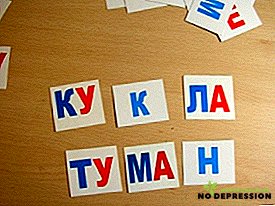In elementary school, teachers often conduct reading techniques as a criterion for evaluating a child’s skills and performance. Periodically, children must read the text at a time. First, an excerpt from a familiar work is selected, and in subsequent checks an unfamiliar text is given.
The reading technique should determine how many words the child reads per minute and whether he understands the text he has read. It also takes into account the correctness of the pronunciation of words and endings, the presence of errors and repetitions.

The ratio of class and required reading speed:
- Grade 1 - at least 3 words per minute;
- Grade 2 - more than 50 words per minute;
- Grade 3 - from 70 words;
- in 4 - the beginning of grade 5 - more than 100 words per minute;
- in high school - from 120-150 words per minute.
The indicator to which you want to strive for - 150-180 words per minute. This is when reading an unfamiliar text.
Teaching a child to fast reading is needed immediately, as you begin to learn to read in general. When the child already knows all the letters and can read by syllables, you can begin to perform exercises to increase attention, replenish vocabulary and improve diction. All this will help to master the speed reading in the future.
 The hardest question is when to start learning to read. It is best to do this when the baby is already able to speak, expressing his thoughts in a logical and in the form of a short story. Approximately it is 4-5 years old.
The hardest question is when to start learning to read. It is best to do this when the baby is already able to speak, expressing his thoughts in a logical and in the form of a short story. Approximately it is 4-5 years old.
The speed of reading affects the overall development of the child and school performance. What may need the ability to quickly read:
- increase vocabulary;
- development of logical, spatial thinking;
- reading speed directly affects the amount of digestible information, with a high reading speed, 80% of the text is perceived, while at a low speed only 60% or less;
- reading skills make it easier to learn other school subjects.
Reasons for slow reading
Slow reading, including reading by syllables, not only acts as an obstacle in the development of any opportunities, but also in general progress and getting good grades. Low speed has its own reasons, the elimination of which will already solve half of the problem:
- Low memory level. In childhood, a child's memory is not yet well developed. When a baby reads 4-5 words, he no longer remembers which one was the first. As a result, he loses his thought and does not understand what is being said. This not only affects the absorption of the material, but also the interest in the process.
- Distracted attention. The speed of thought processes is high, and when reading slowly, the kid begins to think about something other than text. He is distracted, he becomes bored and interest in books and learning disappears.
- Low operational vision. When reading the text, the baby sees only a few letters (1-3), and not the word as a whole.
- Recurrent eye movements. When reading, the child begins to return with his eyes to the already read text and rereads the word again.
- Underdeveloped articulation apparatus. In this case, the children find it difficult to pronounce words and because of this the speed decreases.
- Literature chosen not according to the age and knowledge of the child.

How to start learning
To teach a child speed reading, you need:
- eliminate the causes of low speed, which was mentioned earlier;
- develop a child's interest in the process, so it is best to do exercises in the form of a game, praise and come up with small rewards (going to the movies, walking, but don’t encourage with money);
- prepare or purchase materials for classes (cards, tables, etc.);

- get a literature suitable for the child’s age and necessarily interesting for him (therefore, take into account his hobbies);
- observe the regularity of classes, but make them short (up to 30 minutes at a time).
With fast reading, a person is able to guess about the following words and the continuation of thought, which greatly improves speed. For the development of this quality are important memory, vocabulary, attention, a high level of operational vision, developed thinking.
They need to be developed, just an increase in the readable text will not help to improve performance.
How to teach quickly read a child of preschool age
A child of preschool age is just beginning to learn, and this process is still difficult for him. Therefore, it is important to constantly maintain his interest in the process and present games in the form of games and entertainment.
Three games that will help develop the skills necessary for fast reading:
- During the walk, practice searching for items on a specific letter. Suggest to find around objects with the name of the letter H (or any other), do not stay aside and join your baby. Such a simple exercise will be interesting and will help develop memory, attentiveness, vocabulary and thinking.
- To increase the skills of predicting words, you can use the exercises on the preparation. Get cubes with letters and offer your child to make individual words from the letters proposed, the more they will be, the better. You do not need to take a lot at once, take only 10 cubes and experiment with them.
- Another option is to make words not from individual letters, but from syllables. To do this, you can buy cards or do it yourself (which is very simple). Take about 10 small words (2-3 syllables) and divide it into 2 parts, writing down syllables on different cards. Suggest baby make whole words. Then you can add more complex structures, dividing them into 3-4 parts.

Methods and exercises for learning fast reading of children at the age of 6 and 7
With children 6-7 years old, you can use exercises more difficult. But do not forget to maintain interest, conducting classes in the form of games and competitions.
How to teach a child in grade 1 to read quickly and easily? For lessons to increase the speed of suitable different methods of reading. They will make this process more interesting and will develop the thinking of the baby:
- Parallel reading. For this exercise you will need two identical text. One you read, but in a different way the kid is watching you. At any time, you can stop and ask to find any read word or read the last few words.
You can also ask to continue reading, referring to the fact that you are tired. After a few sentences, thank and continue on your own.
- Reading a passage at a time. Choose a test familiar to the child and offer to read the passage. Note the minute and then count the number of words. Interest read again, saying "I know you can do more" or something like that. Mark the minute again and let the same passage read.
The second time, the child will read more words and begin to read an unknown text. Praise him and tell him how much more he could read, the child will be pleased with his progress and will gladly agree to do so further. - Buzz. This technique is aimed not only at developing speed, but also at increasing concentration. The child should read the text in silence, and aloud at this time to hum. This technique, though strange, but with regular classes will show a good result and be sure to please the baby.
In addition to different methods of reading, you need to use various exercises:
- Improved articulation. Speak different tongue twisters, watching for correct execution. You can arrange a competition, and who better cope will receive a small prize.
- The development of ingenuity. Take a sheet and write pairs of words, similar in writing and sound, but differing in meaning and in one letter, for example, cat - sweat, wood - weight, sleep - tone, etc. Ask the child to find the difference and explain the meaning of each word.
- Development of the visual field. Take the table, for a start limit to 5 columns and 5 lines. In each cell, enter a letter or syllable. Ask the child to read them all to themselves, and then, at the request, name their order, find a specific letter, or name the next letter from the given one. To increase the difficulty, increase the number of letters or use syllables.

A cursory reading program for children over 8 years old
Consider how to teach a child to read quickly and correctly, starting with grade 2 and above. For older children need to complicate the load. Make the exercises more difficult, set certain tasks for them.
For example, you can write some long word (diamond, agricultural, etc.) and offer to make 5 other words from its letters. Gradually, you can complicate the task and increasing the number of words.
Other exercises, developing abilities for fluent reading:
- The development of anticipation (prediction of the subsequent word, semantic guess). It is necessary to write out the sentences and skip the letters in some words, and then ask the child to read it, while inserting the missing parts. Over time, increase the load removing entire syllables from words.
- Deformed sentences. It is necessary to write out sentences with disturbed word order. For example, instead of "Nikita went to the forest for mushrooms" write "Nikita for mushrooms the forest went to". Make a few different cards, and then ask your child to make sentences correctly.
- Writing out loud. The essence of the exercise is that you need to give your baby the initial phrase or question and 5-10 minutes to think it over. And then he must express his attitude to the problem or tell a fictional story. It is necessary to follow the harmony and logic of the story.

In addition to the exercises, there are also a number of text reading techniques:
- "On the heights". You need to take an opaque ruler and close the bottom of the text. The child should read the text only on the top of the letters. After such an exercise will not cause difficulties, close the top of the text.
- Changeling. This technique is performed in three stages. First you just need to read the text, then the book turns over 90 degrees. After a few sentences, turn the book 180 degrees and the words are perceived "upside down."
- Role reading Reading with the change of intonation allows you to better understand its essence and remember. Children in this case concentrate on the written, and the new words are better remembered.
How to quickly teach a child to read in English
Teaching a child to read in English is more difficult than in his native Russian.
This is associated with a frequent problem when it is not read as it is written. In addition, English words are not readable by syllables and have to utter the word completely.
Three methods, compliance with which will help teach your baby to read in English:
- Learn the letters. Before moving on to read, study the alphabet. He needs to know very well and calmly pronounce individual letters.
- Choose short and unambiguous words. In order not to confuse the child at the very beginning and not to “discourage” his interest in learning, find a list of simple words. They should correspond to the writing and reading, this will allow the baby to take the first steps in the study.
Examples of suitable words to start with are pot, spot, dog, box, etc. Gradually, you need to move on to reading more difficult words. Pay attention to the baby remember the correct pronunciation and not make mistakes. - Reading with understanding. After the basic words are learned and easy to read, you can move on to acquaintance with short texts. Ask the child, after reading, to talk about what he read.
Do not demand the perfect translation, you need to achieve meaningful reading, and not just mechanical reproduction. Ideally, the child should then read a foreign text, understanding everything along the way. As when studying the material in their native language. This will make it difficult for him to read well, but also to master English.

Tips for parents
When teaching a child, you need to constantly maintain interest in the process and not overwork the baby.
A few more important points:
- make the process interesting and exciting, constantly stir up interest;
- Do not forget to praise the kid for his achievements, but it is absolutely impossible to blame for failures;

- make classes varied, using not only different ways of reading, but also developmental exercises;
- Remember that reading speed directly depends on thinking, attention, vocabulary and ability to concentrate;
- make reading not a duty and a routine, but a hobby and a useful habit, for this buy interesting books for your kid, read aloud and offer to read stories in turn;
- train in retelling books that are currently reading; ask not only the child, but also speak for yourself (naturally, adapting the story to the understanding of the baby).
And most importantly, do regular classes. Optimally, there will be 3-4 lessons per week in conjunction with school tasks. You can periodically replace one exercise with another, making it more varied and interesting.
Additional information on learning to read is in the following video.
















